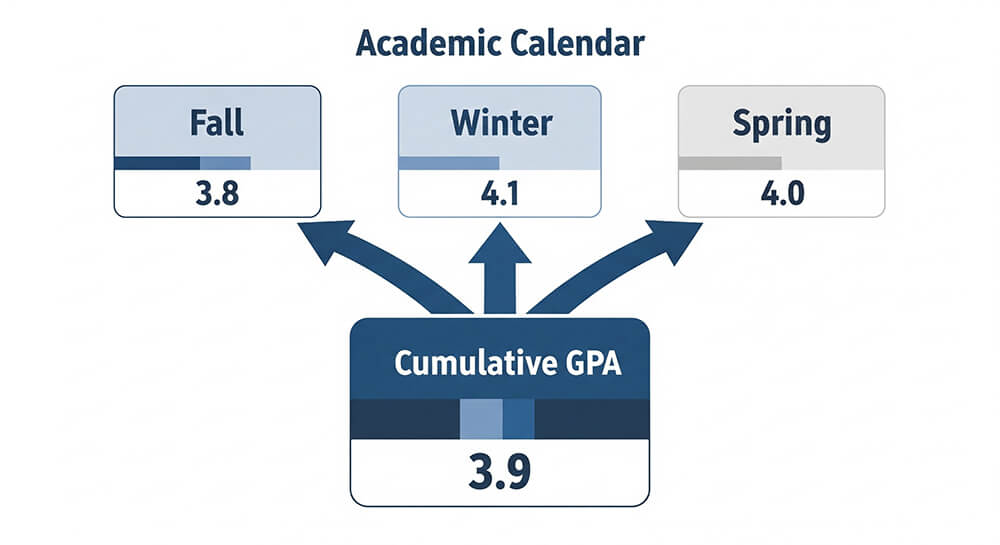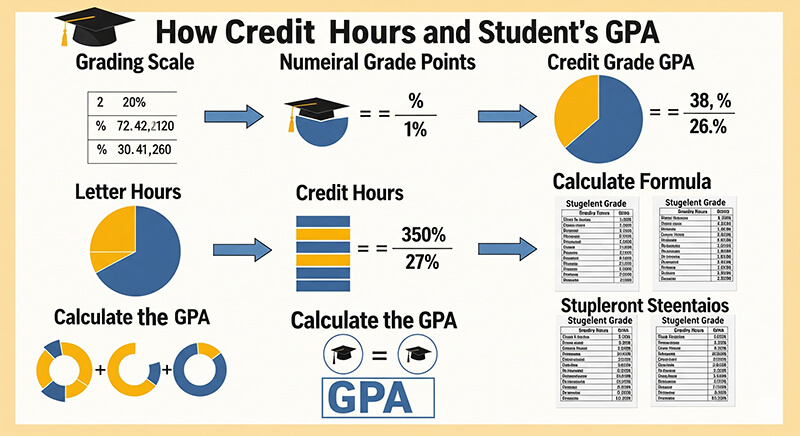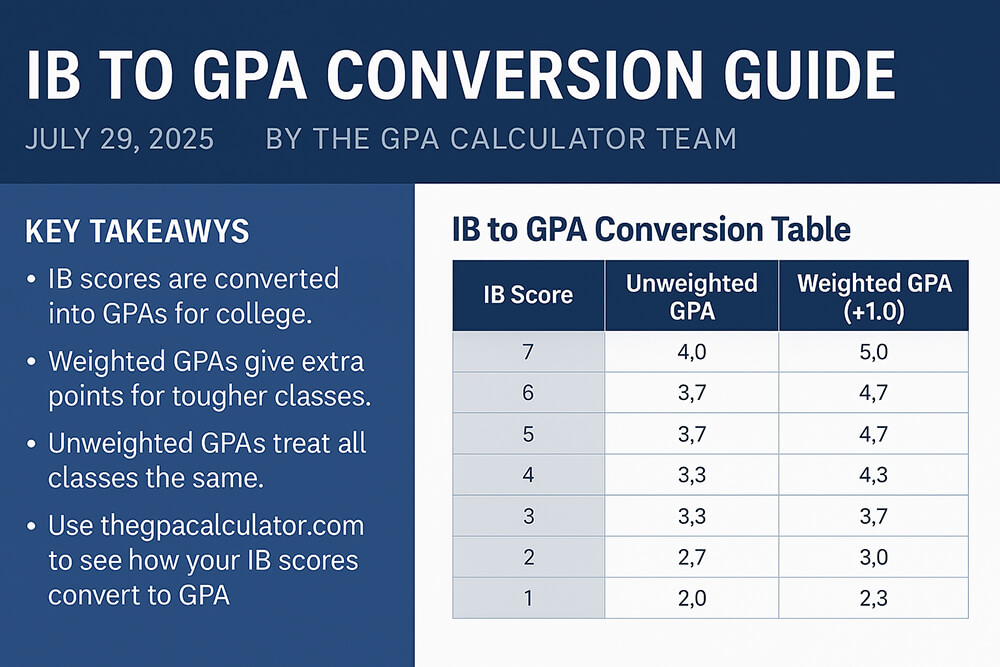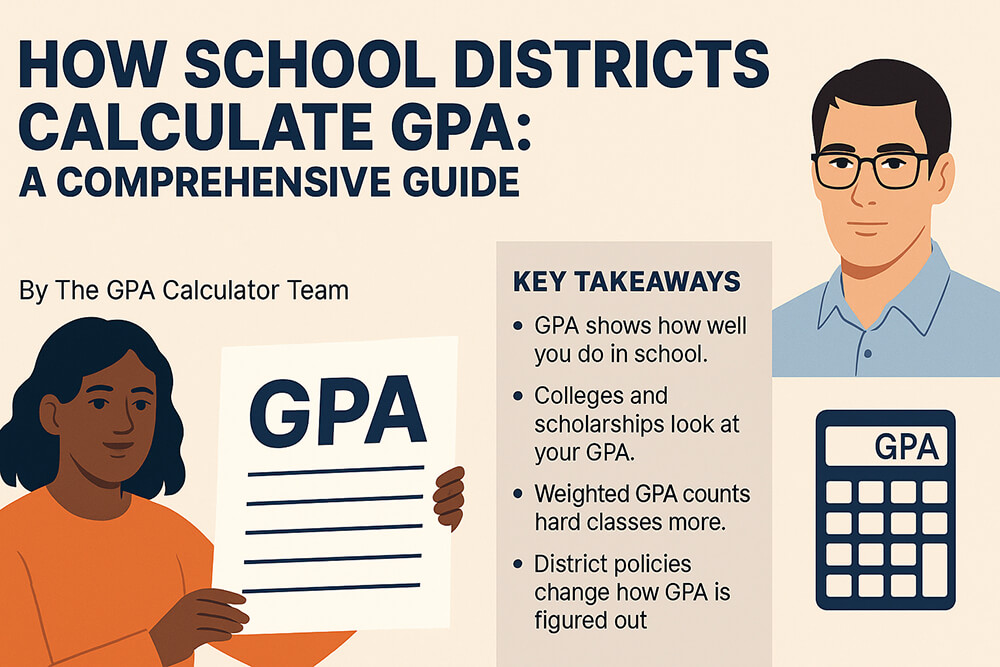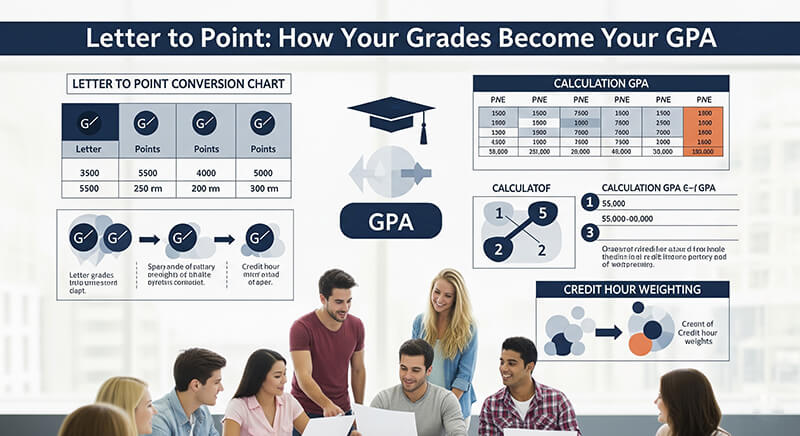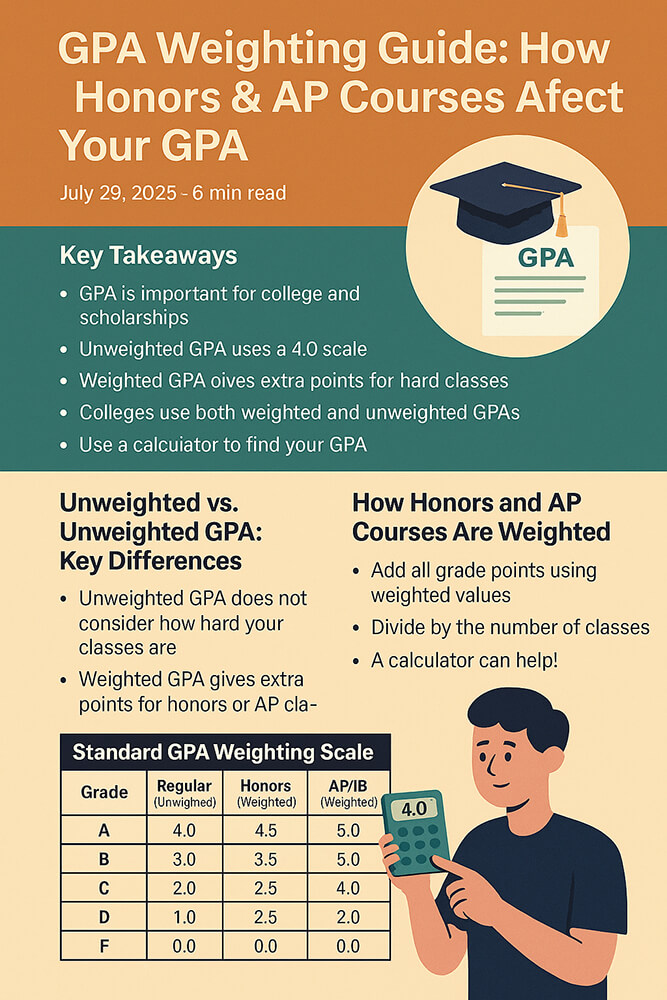Key Takeaways
| Feature | Description | Importance |
|---|---|---|
| Trimester System | The school year has three terms, each about 12-13 weeks long. | Allows students to focus on fewer classes at once and provides more chances to improve grades. |
| GPA Calculation | GPA is found by dividing total quality points by total credit hours. | Essential for tracking academic performance for college applications and scholarships. |
| Weighted vs. Unweighted | Unweighted GPA is on a 4.0 scale. Weighted GPA adds points for Honors (+0.5) and AP (+1.0) courses. | Weighted GPA shows academic rigor, which is important to competitive colleges. |
| Online Calculator | A tool that automates GPA calculations for trimesters, including weighted and unweighted options. | Simplifies tracking, reduces errors, and helps with planning for future courses. |
High school students know their Grade Point Average (GPA) is a key number for their future. It helps with college admissions and scholarships. Some schools use a trimester system. This system divides the year into three parts. Calculating your GPA each term is very important. A Trimester GPA Calculator makes this simple. It can figure out both your unweighted (4.0 scale) and weighted (5.0 scale) GPA. This helps you see how you are doing in all your classes.
What Is a Trimester System?
A trimester system splits the school year into three terms. Each term is about 12 to 14 weeks long. This is different from a semester system, which has two longer terms. With trimesters, students often take fewer classes at one time. This can help them focus better on each subject. You get a GPA for each trimester. You also have a cumulative GPA, which is the average of all your trimesters.
Understanding Weighted vs. Unweighted GPA
Your GPA can be calculated in two main ways: weighted or unweighted. An unweighted GPA uses a simple 4.0 scale. An 'A' is 4 points, a 'B' is 3 points, and so on for all classes. A weighted vs. unweighted GPA considers the difficulty of your courses. Harder classes, like Honors and Advanced Placement (AP), add extra points. This shows colleges that you are challenging yourself with difficult work.
How to Calculate Your Trimester GPA
Calculating your GPA involves a few simple steps. You need to know your grades, the type of class, and how many credits each class is worth. Following a clear process ensures you get an accurate result. You can learn the basics of how to calculate GPA to understand your academic standing. This knowledge helps you monitor your progress throughout the school year.
Step 1: Convert Your Letter Grades to Points
First, you need to change your letter grades into numbers. On a standard scale, an A is 4.0, a B is 3.0, a C is 2.0, and a D is 1.0. An F is 0 points. This is the first step for any GPA calculation. A letter to point GPA conversion guide can show you how each letter grade translates to the 4.0 scale.
Step 2: Understand Quality Points
Quality points are the total points you earn for a class. You find them by multiplying the grade point by the number of credits for that course. For example, if you get an 'A' (4.0 points) in a 1-credit class, you earn 4.0 quality points. The difference between Quality points vs. GPA explained is that quality points are for one class, while GPA is the average for all your classes.
Step 3: Use the GPA Formula
The GPA formula is simple. You add up all your quality points. Then, you divide that total by the total number of credit hours you have taken. The result is your GPA. A GPA formula guide breaks down this math for you. Using this formula correctly is key to getting the right GPA.
The Role of Credit Hour Weighting
Credit hours show how much a class is worth. A full-year class might be 1 credit, while a shorter class might be 0.5 credits. Classes with more credits have a bigger impact on your GPA. A credit hour weighting GPA guide helps explain how this works. It is important to know the credit hours for each class to calculate your GPA correctly.
Calculating Weighted Grades for Honors and AP Courses
Honors and AP courses add extra weight to your GPA because they are more difficult. Typically, an Honors class adds 0.5 points to your grade. An AP class adds a full 1.0 point. So, an 'A' in an AP class becomes a 5.0. This is why weighted GPAs can be higher than 4.0. Our GPA weighting guide for Honors and AP provides more details on this.
What About IB and Other Programs?
Some schools offer International Baccalaureate (IB) programs. These are also advanced courses that can boost your weighted GPA. The weighting for IB classes is often similar to AP classes. If you are in an IB program, you can use an IB to GPA conversion guide to figure out your GPA. This helps you see how your hard work in IB classes pays off.
How Different School Districts Calculate GPA
Every school district can have slightly different rules for calculating GPA. Some might use a 5.0 scale, while others might use a 6.0 scale for weighted GPAs. It is important to know how school districts calculate GPA at your school. You can usually find this information in your student handbook or on the school's website.
Does a Pass/Fail Grade Affect Your GPA?
Some classes might be graded as pass or fail instead of with a letter grade. Usually, a passing grade does not affect your GPA. A failing grade, however, will count as a 0 and can lower your GPA. Learning how pass-fail grades impact your GPA is important if you take any of these courses.
Common GPA Calculation Errors to Avoid
It is easy to make mistakes when calculating your GPA by hand. Some common errors include using the wrong grade points or mixing up credit hours. Knowing the common GPA calculation errors to avoid can help you get a more accurate number. Using an online calculator is the best way to prevent these mistakes.
Understanding GPA Inflation
GPA inflation means that the average GPA of students has been rising over time. This is partly because more students are taking weighted courses like AP and Honors. The guide on GPA inflation vs. deflation explores this trend. It helps to understand that a high GPA is now more common, especially for students applying to top colleges.
Common Myths About Weighted GPA
Many people have wrong ideas about weighted GPAs. One myth is that taking easy AP classes is better than getting a good grade in a regular class. Colleges look at both the grade and the difficulty of the course. Our article on weighted GPA myths debunked clears up these and other misunderstandings.
Use a Trimester GPA Calculator for Easy Tracking
A Trimester GPA Calculator is the easiest way to keep track of your grades. You just enter your courses, grades, and credits. The calculator does all the math for you. It can show you both your weighted and unweighted GPA for each trimester and your cumulative GPA. This helps you see your progress and plan for the future.
Why Your Trimester GPA Matters
Your trimester GPA is a snapshot of your academic performance. It helps you see where you are strong and where you need to improve. Colleges look at your GPA to see if you are ready for their courses. Many scholarships also require a minimum GPA. Keeping an eye on your GPA each term helps you stay on track for your goals.
Frequently Asked Questions (FAQ)
What is a good GPA on a trimester system? A good GPA depends on your goals. For competitive colleges, a weighted GPA above 4.0 is often expected. An unweighted GPA above 3.5 is generally considered strong.
How is a trimester GPA different from a semester GPA? The calculation method is the same. The main difference is the time frame. A trimester GPA is calculated three times a year, while a semester GPA is calculated twice a year.
Do colleges look at trimester GPA or cumulative GPA? Colleges look at both. They will review your grades from each trimester to see your progress over time. Your cumulative GPA, which is the average of all your terms, is most important.
Can I calculate my GPA for just one trimester? Yes, you can calculate your GPA for a single trimester. This is a good way to check your performance in the short term and make adjustments if needed.
